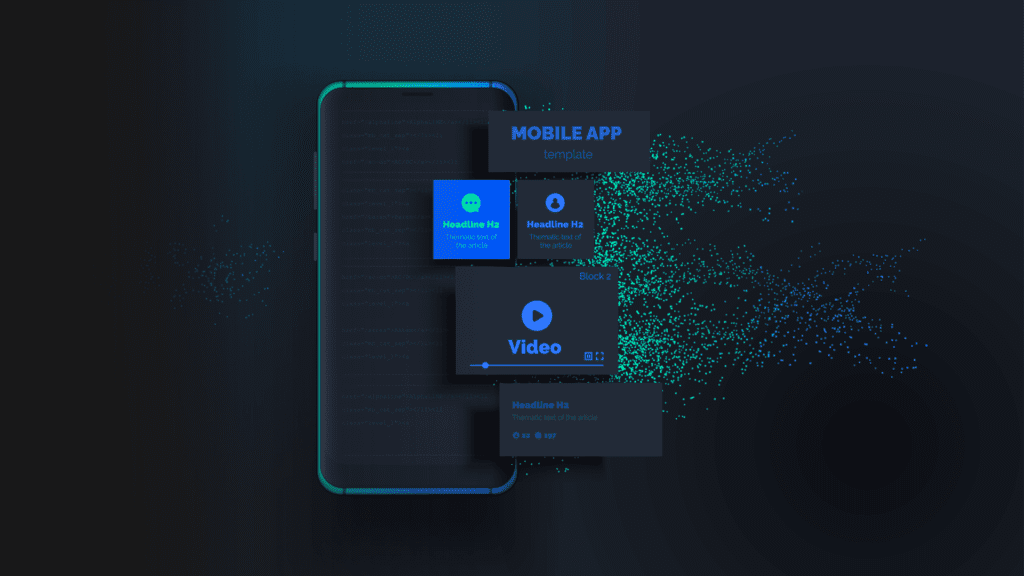How to Build a Mobile App Development Team: Structure & Roles Needed for Success
The mobile app development industry will likely reach the trillion-dollar mark by the end of 2023, given that nearly half of small businesses have dedicated digital platforms to connect with customers. Businesses that want to save costs, access wider talent pools, and exchange innovative ideas, often turn to a dedicated team, instead of hiring in-house developers.

However, working with an external team can be pretty daunting at first. It will help if you understand how to build an app development team from scratch, the different roles and responsibilities of team members, as well as the right team structure that will deliver high-quality cross-platform or native apps. So, how do you go about it? Here is a quick guide to help you get started.
Mobile App Development Team Structure
The mobile app team structure of your choice largely hinges on the complexity of your app idea, which is driven by intricate business needs. Nonetheless, a prevalent mobile application development organizational structure for a small to midsize digital solution looks like this:
Project Manager/Product Manager
Although many people tend to overlook the position of a project manager (PM), this professional is technically in charge of the overall project’s success. Typically, a PM, sometimes referred to as a product manager, ensures that the mobile app development team structure flows smoothly from the top to bottom by overseeing the planning and execution of delegated roles.
Key Tasks
- Build a formidable mobile app idea
- Onboard and lead the mobile app development team
- Monitor development progress
- Evaluate project performance
Skills
- Time and team management
- Leadership and negotiating skills
- Critical thinking
- Robust technical proficiency in mobile development services
- Great interpersonal skills
Responsibilities
- Development plans assembly and roles assignment
- Development budget optimization
- Ensures deadlines are met
- Coordinate effective communication with all stakeholders involved
- Handle all client requests
Business Analyst
A mobile app company’s organizational structure wouldn’t be complete without a professional business analyst to bridge the gap between technical developers and relevant stakeholders to ensure that the end software product is in line with business needs, vision, and goals. A business analyst is instrumental in enhancing efficiency through real-time data analytics.
Key Tasks
- Prepare functional requirements for the mobile app
- Define the metrics for measuring app success
- Create a roadmap to expedite app delivery
Skills
- Strong oral and written communication skills
- Documentation and visualization skills
- Analytical thinking
- Decision-making skills
- Problem-solving skills
Responsibilities
- Conduct in-depth research on business challenges and opportunities
- Keep tabs on the development process
- Gather feedback from end-users during the trial and maintenance phases
- Establish acceptance criteria for key mobile app features
- Come up with new ideas to improve the app business-wise
UI/UX Designer
A UX/UI designer ensures that the user interface of your product looks and functions as intended, as well as promotes an overall great user experience. The roles and responsibilities of this talent in a mobile app team structure cut across the whole mobile app software development process, from design, all the way to marketing.
Key Tasks
- Conduct surveys and research to build an ideal user persona
- Build information architecture for the digital solution
- Create style guides for the development process
- Test the mobile app before release and deployment
Skills
- UX research and analytics
- UI prototyping
- UI wireframing
- HTML and CSS skills
- Flexibility
- Innovative mindset
Responsibilities
- Gather and evaluate user requirements
- Illustrate design ideas to the mobile app development team
- Design graphic user interface features, such as navigation tabs
- Create ideal user journeys to unravel pain points
Mobile App Developers
A typical mobile app company structure also comprises developers, who are instrumental in supporting the product’s lifecycle, starting from the ideation stage to deployment and maintenance. Key talents, mobile app developer skills, as well as their roles in the app development team include:
| Talent | Key Tasks | Skills |
| iOS Developer | Design and build iOS platform applications Write and maintain code quality User interface designing Automate unit tests for applications | iOS app development fundamentals (Swift and Objective-C) Grand Central Dispatch (GCD) for high performance Testing UI/UX designing Innovative mindset |
| Android Developer | Build the application design Write code for the app Test application to ensure successful app deployment Facilitate ongoing maintenance and technical support | Android app development fundamentals (Java, Kotlin) Android UI experience Interactivity design skills Testing Innovative mindset |
| Cross-platform Developer | Build cross-platform applications for iOS and Android Write code for applications Maintain app testing Debugging | Flatter and React Native proficiency Cross-platform testing Extensive expertise in both iOS and Android |
QA Engineer
A QA engineer plays an integral role in a typical mobile app company organizational structure, as far as ensuring that the end-product performs optimally is concerned.
Key Tasks
- Write and plan test cases
- Configure testing environment
- Run scripts for automated tests
- Generate testing reports
- Gather feedback from developers and technical specialists
- Provide overall software quality assurance services
Skills
- Software development lifecycle (SDLC) understanding
- Hands-on skills in software testing tools
- Static software testing
- Analytical mindset
- Effective communication
Responsibilities
- Discover quality and security vulnerabilities in the business app
- Inspect the app for bugs or any defects
- Evaluate compliance with third-party components
- Ensure product quality and business operational logic
Other Mobile App Team Members You Need for Different Projects
Building an application development team can also mean hiring other specific roles that can help you build a powerful digital solution for a certain industry niche. That said, other app development team roles that might be needed for select tasks include:
2D/3D Artists
Quite rare, but sometimes a mobile app development team structure projects for building gaming or marketing applications require 2D/3D talents to create animated characters, as well as 3D product models. The talent can create these concepts using computers or by hand, as long as the end design is in line with the client’s business requirements. Prevalent skills of 2D/3D artists include game engine understanding, creativity, 3D modeling, as well as drawing and illustration.
Web3 Developers and Consultants
The race to a decentralized internet is tightening, and projects that want to stay in the loop often hire Web3 developers and consultants to build and deploy applications on blockchain networks. Consultants are responsible for proposing and implementing innovative integrations to the decentralized world, known as the Metaverse. Skills of a Web3 developer include front-end development, smart contract development, API integration, pattern designing, and proficiency in JSON RPC programming language.
Are you looking to build an effective mobile app development team?
Mobile App Development Stages and Team Roles
Now that you understand mobile app development team roles and responsibilities, how do they intersect at different stages of the entire development process? Well, this depends on the type of development process and the number of stages involved. Every development stage involves various team members or all of them altogether to focus on the core goal.
Here is a typical flow of app development project roles and responsibilities throughout the building cycle:
Stage 1 – Discovery
As the name suggests this stage involved revealing more information about the app in terms of the target audience, goals, the size of the team needed to complete the work, as well as features proposal. In other words, all panning takes place here with the supervision of the project manager. Other talents involved in the discovery phase include business analysts, UI/UX designers, and all developers.
Stage 2 – Idea Validation
Idea validation involves gathering any information that can back the application’s vision through experimentation. The goal is to come up with a future-proof digital solution, with risks anticipated and mitigated even before the development begins. Team members required to implement idea validation include business analysts, QA experts, project managers, as well as big data engineers for real-time, data-driven insights.
Stage 3 – UI/UX Strategy
The idea validation phase gives feedback and recommendations in terms of the app’s usability. This is followed by a UI/UX strategy to implement the feedback, as well as conduct in-depth research on focus groups to polish the user interface as much as needed. The mobile application development organizational structure in this stage includes a UI/UX developer and a QA engineer to ensure that the end product prototype is highly interactive before taking the same to pre-development testing.
Stage 4 – Design and Development
This stage is dominated by developers who write code to program features and build the product simultaneously. The product manager closely monitors the development process and ensures that the talents stick to the plan, as far as time-bound deliverables and quality consistency are concerned. The app at this stage is classified as a minimum viable product (MVP) that is feasible as the designed concept but with limited capabilities.
Stage 5 – Testing & Debugging
The app is refined and made ready for deployment at this stage. The QA engineer will hunt for possible bugs and fix them, as well as issue recommendations for improving the user interface. This can include proposing element redesigns or introducing new integrations altogether. The product manager also features at this stage to help the client understand the proposed changes and how they influence their organization.
How to Choose the Right Size of Your App Development Team
Now that you understand how a mobile application development team structure looks, how do you choose the right team size? From the above sections, you can notice that a typical project requires an average of 5 to 10 roles. The number of talents, hence the team size, to fill up these roles depends on several factors, such as:
The Size of the Project
The size of the project determines the completion time. A bigger, time-bound project would mean hiring as many talents as possible to build faster and simultaneously. For instance, you might need two backend developers to share task loads and reduce the time to market for your mobile app.
The Complexity of the Project
The size of the mobile application development team structure required to build a complex app is bigger than for simple apps. In the case of simple to medium apps, some developer roles can cut across various functions. However, for a complex app, you might need to hire specialist developers for particular functions to ensure that they program high-tech features.
Are You Building a Cross-Platform App?
Unlike native apps, cross-platform applications only require one team of programmers to build and maintain them. That said, you might not need to hire as many roles as you would for both Android and iOS development. Besides the programmers, you’ll only need a project manager, UI/UX designer, and QA specialist.
Do You Have an In-House IT Department?
You might not need a bigger mobile application development team structure if you already have an in-house department for your IT smartphone products because this changes your outsourcing needs. For instance, your project might only require outsourcing a part of it, such as manual and automation testing.
The Pros and Cons of Different Models for Hiring Specialists to Develop Your Mobile App
| Hiring Model | Pros | Cons |
| In-house | Long-term collaboration 100% control Greater security for IP Ideal for enterprise-scale projects | Relatively costly Hiring bottlenecks Slower innovation |
| Freelance | Cost-efficient Ideal for one-off projects Direct contact with developers Access to global talent markets | Quality assurance issues Wrong client-talent match cases are high Cybersecurity risks Security vulnerabilities for IP |
| Outstaff | Relatively affordable Mitigated hiring bottlenecks Direct project supervision | Expensive to manage Language barriers Time-zone differences IP security vulnerabilities |
| Outsource | Match with relevant expertise Faster innovation Rapid development Relatively affordable | Quality inconsistencies Can be costly in the long haul—for a long-term project |
| Newxel dedicated teams | Swift staff augmentation and software engineer onboarding—within 3-5 weeks Turnkey services for global R&D centers Long-term engagement due to better retention rates Global hiring capacity for any team size | Might take time to find qualified specialist developers |
8 Steps to Build an App Development Team Effectively
A dedicated mobile app team structure can help you optimize costs and build faster while the anticipation of your new digital solution is still hot. Here is how to build a successful mobile app company organizational structure from scratch in 8 simple steps:
- Reach out to a full-service company such as Newxel
- Submit project requirements
- Discuss the number of roles and talents needed for the project
- Pick a suitable hiring location
- Shortlist and interview potential team members
- Team building
- Onboarding
- Project kick-off and get real-time reports from the PM
How Much Does it Cost to Build a Mobile App Development Team?
Although most team members in a mobile app company organizational structure will charge an average hourly rate of about $50, the true cost of building your dedicated team depends on several factors, such as:
Project Type and Scope
The more complicated your mobile app project, the longer it will take to complete. That means added costs, whether you are paying per milestone or hourly basis. Alternatively, to build faster, you can hire many developers at a steep price to build rapidly.
Cooperation Model
Working with freelancers will obviously cost lower than in-house and with a dedicated mobile app company organizational structure. Similarly, an outsourcing agency might also charge relatively affordably due to economies of scale. These agencies usually enjoy cheap labor from developing countries, which of course, come at the expense of quality.
Hidden Costs
The hidden costs of working with remote development teams depend on the hiring location. For instance, the local country might require you to pay extra costs in employee benefits as anchored in law. This can include bonuses, allowances, or even insurance.
Particular Tips to Create an Effective Mobile App Team Structure
Every business owner endeavors to build a mobile application development organizational structure that they can trust and enjoy long-term collaboration with. With that in mind, it will help if you employ various practical tips post-hiring to ensure that you save time by working with value-matched talents only that add value to your project. Ensure that you pay attention to:
Hiring Costs:
the goal is to hire a relatively affordable talent that doesn’t compromise quality simply because they charge less. Ensure that you discuss costs beforehand and agree that it won’t hinder quality consistency before signing the contract.
Expertise:
You can gauge a developer’s or any other team member’s level of expertise from their online ratings and reviews from other clients. This gives you an overview of how it feels or looks like working with the said talent.
Accessibility:
You want to work with a mobile application development team structure that is easily accessible for real-time communication and collaboration, especially if you are going to build on consensus. That said, consider language barrier, geographic, and time-zone limitations.
Personal Preferences:
Know how to build an app development team and hire talents that embody your brand ideals, as well as personal preferences to ensure a smooth workflow. Unless you are comfortable with talent, don’t include them in your team.
Non-Disclosure Agreements (NDAs):
IP security is a concern when it comes to working with dedicated teams. Ensure that your team members sign NDAs so that they can have a legal responsibility in safeguarding your IP and trade secrets.
How to Build a Successful App Development Team: Newxel Experience
Newxel is a full-service company that offers various engagement models for mobile app development roles, including dedicated teams, global R&D centers, and distributed teams. We can help you fill in any talent role in your software development team within 3 to 5 weeks, depending on the tech stack combination, as well as the hiring location.
Over the years, we have helped businesses scale to emerging innovative fields, such as Fintech with dedicated teams. A happy client came to us, seeking to expand its mobile application development team with dedicated teams in Ukraine. We embarked on the hiring journey and provided 100% suitable professionals for the client to choose from, after rigorous evaluation.
On top of assembling a mobile app team structure, we offer other turnkey services as well, including office space branding and management, HR & accounting, full financial & legal support, and ongoing IT assistance.
Wrapping It Up
This guide gives in-depth on how to build a successful mobile app development team, as well as members’ roles and responsibilities. Working with dedicated teams is a viable option for both small and big businesses that want to experience the benefits of building mobile apps with closely-knit talents to ensure quality consistency.
Don’t hesitate to get in touch with Newxel experts if you want to build your team from scratch or hire app developers in Eastern Europe or elsewhere around the globe.





